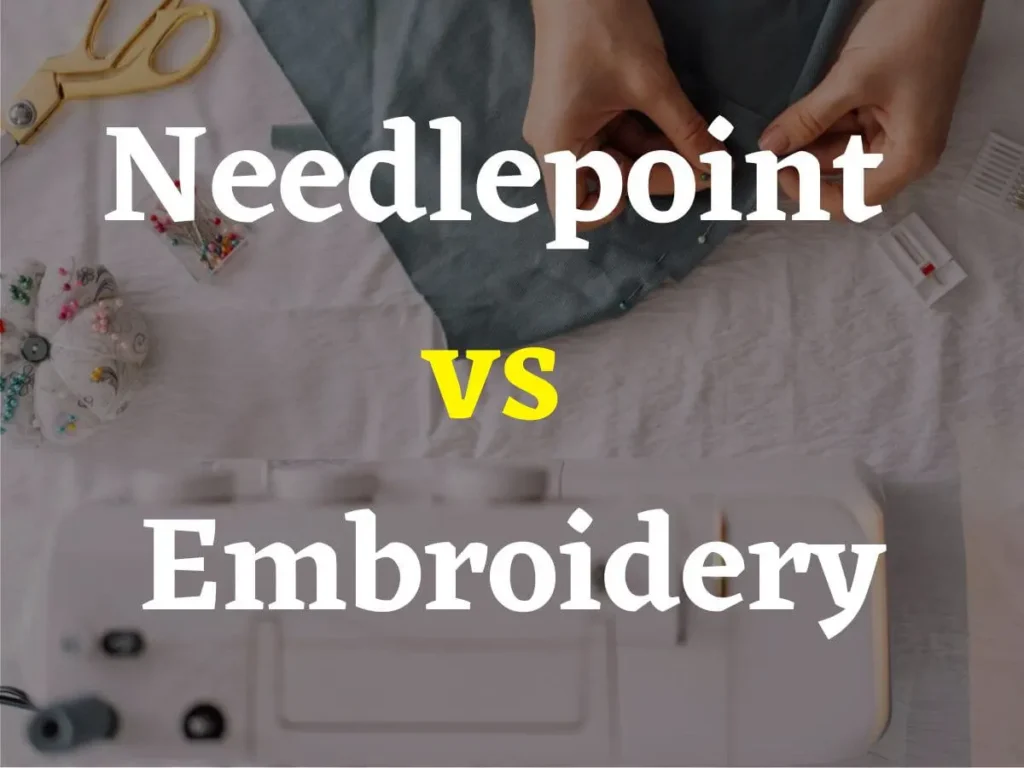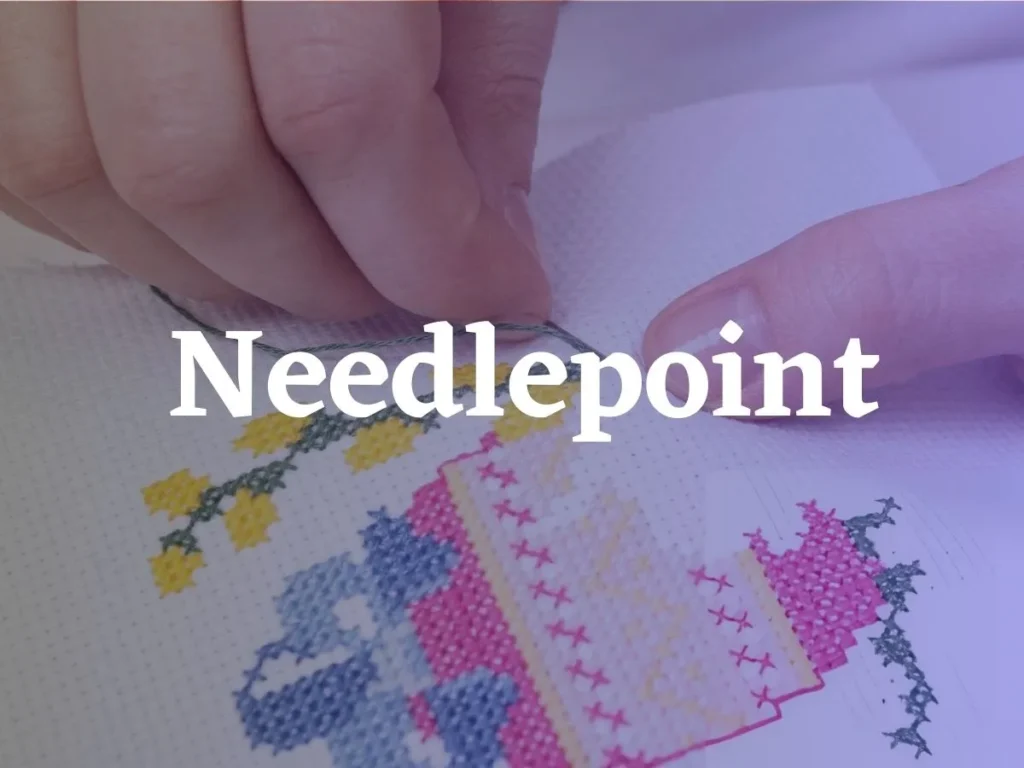
If you are familiar with the terms “Needlepoint”, and “Embroidery” then it’s possible that you may struggle to find which technique is easier to learn and or more suitable for beginners and specific projects.
Many people often do not know the difference between Needlepoint vs Embroidery, they are always stuck between “Are these two of the same kind?” or “They are different?”.
To simplify it, embroidery is the type of artwork that can be done on any fabric using needle and thread, and needlepoint is the type of embroidery technology that handles the upper side of cloth or canvas. Needlepoint seems old-fashioned, but the young generation still loves it as a hobby for free time.
Needlepoint differs from embroidery in several aspects. The major difference among them is that needlepoint generally worked on a stiff, open-weave canvas. In contrast, embroidery can be used on a variety of fabrics including cotton, silk, or linen without the need for open-weave canvas.
The purpose of this article is to highlight the key differences between Needlepoint and embroidery so users can make an informed decision.
Rather you want to know the Time Commitment, Project Goals, material selection, or difficulty level of these embroidery techniques. Because each method you select will shape the future of your final look.
What is Needlepoint?

If we go back to the history of rich ancient Egypt, needlepoint carries with it a legacy of artistry and devotion. Often believed to be one of the earliest forms of decorative stitching. They loved stitching with their hands.
Egyptian artisans stitched detailed patterns onto canvas, which turned each thread into a part of their stories and dreams. But after so many years, this technique is still alive in this modern and digital era.
Needlepoint is a kind of sub-category of embroidery, in which designs are stitched onto a stiff open-weave canvas using a needle with the help of thread or yarn.
You can create detailed, decorated patterns with the help of stitches, Hand made wall hangings, pillows, and many other decorative items can also be made through this method.
Needlepoint is the cousin brother of cross stitch, while they both are types of embroidery it offers only two types of stitches X-shape and half cross stitch.
Needlepoint on the other hand has a variety of stitches to play around such as tent stitches, basketweave stitches, cashmere stitches, brick stitches, basic mosaic stitches, and many more.
Among all these tent stitches are very popular due to their small, diagonal stitches that coat one intersection of the canvas.
All you need is a canvas, needle, and thread to get started with needlepoint. There are a variety of needles available in the market but tapestry needles are popular among needlepoint lovers because it has a large eye for yarn to fit in.
These needles are available in different sizes so that you can choose which needle fits better. That’s why it’s recommended to buy a pack of needles. Similarly, use open-weave canvas fabric as it is designed for this purpose.
Like embroidery, needlepoint does not demand a hoop to be placed on the canvas. Stitching can easily be done without hoops. Using hoops sometimes causes a disturbance during work.
Needlepoint takes time and hard work to design but the final look is worth more than you can imagine. The key strengths of Needlepoint are precision, customization, and durability.
What Is Embroidery?

Embroidery has a rich history of crafting handmade designs. It ruled in the Iron Age and the ancient used embroidery to represent their culture. During this period, embroidery was used as a symbol of wealth and status.
Monks and craftsmen made detailed religious clothing and tapestries, such as the Bayeux Tapestry from the 11th century. In the 19th century, the embroidery industry grew and moved from handmade embroidery to machine embroidery.
Nowadays, the latest technologies are used to enhance the embroidery and machine embroidery journey to create vibrant designs. Technology and the modern computerized system have discovered so many ways for embroidery but the hand embroidery stitches will always be a Prized skill.
Embroidery is the process of designing fabric using any thread or yarn with the help of a needle to create intricate patterns, logos, text, or images on materials like clothing, home decor, or accessories.
The major tools used to make quality embroidery are hoops, needles, stabilizers, and thread for designing. You can use any color of thread to achieve your final desired look.
Embroidery applications are widespread across the world. You can see the art of embroidery in sequins, pearls, quills, beads, wool, and ribbons.
Embroidery has various types going from simple hand-made to advanced machine-based embroidery. A few of the most used types are hand embroidery, Surface embroidery, counted-thread embroidery, canvas work, and machine embroidery.
The components used in the creation of Embroidery must be of high quality to avoid any kind of disturbance during work. The needles used in the Embroidery have large holes for different types of threads.
The thread used for creating art onto fabric like cotton, linen, and canvas is made of cotton, silk, or polyester, and comes in various weights and colors.
Similarly, the hoops, and theory are very important in this process and play a crucial role in the completeness of the design. Because its job is to hold the fabric taut while stitching the design on the fabric.
Like hoops embroidery possesses different types of stitches to represent vibrant and cultural artwork. These are some of the commonly used embroidery types:
- Running stitch
- Backstitch
- Satin stitch
- Blanket stitch
- Stem stitch
- Split stitch
- Chain stitch
- Cross stitch
At last, let’s discuss some of the key benefits of embroidery. You can use this technique to make interior designs for your home or office such as wall hangings, create gifts for your kids with your hand, and the best part is you save a lot of money. This is all possible due to its versatility, portability, and intricate designs.
Key Differences Between Needlepoint and Embroidery
Needlepoint differs from embroidery in various factors like canvas, stitches, design, and the final look or finished product. Let’s discuss them in detail:
Canvas: Needlepoint uses a specialized stiff canvas to create more structured and detailed designs. The canvas has a grid of holes that instruct the stitches. Embroidery on the other hand can be stitched on any fabric type like cotton, linen, or silk which gives its user more flexibility So, the major key difference here is fabric.
Stitches: Needlepoint primarily uses a few basic stitches like tent stitch or continental stitch, which are simple and repetitive, while embroidery offers a wider range of stitches for intricate designs e.g. satin stitch, French knots, and chain stitch
Design: Needlepoint produces a more structured and counted design because it is a handmade design and you put a personalized touch to the design. Embroidery allows for more free-form and artistic expression.
Finished Product: The final design of Needlepoint is a thicker, more textured piece because it uses a stiff, open-weave canvas as the base, which requires the entire surface to be covered in stitches. These stitches are usually made with thicker yarns or threads, In contrast, embroidery can be done on a wider variety of fabrics using finer threads, and not all of the fabric is covered in stitch.
Choosing Between Needlepoint and Embroidery
We have already discussed both of these artwork techniques in detail, but the final decision will always depend on you.
Still, if you face difficulty in choosing between Needlepoint and Embroidery then let us make it clearer to you so that you can have deep faith and get started.
The first thing you should consider is your skill level and also your desired outcome. After reading both in detail you should be confident enough to decide which one works for your better outcome.
The next thing you should consider is the time each method will take to create the final product. Generally speaking, Needlepoint will take more time and the reason is obvious due to its detailed and labor-intensive technique.
On the other hand, embroidery offers different types of stitches, some of which can cover larger areas more quickly, like satin stitches or running stitches.
Lastly, make sure to look at your budget and then decide which technique best fits you.
Needlepoint seems to be more expensive due to the thicker threads, expensive canvas, and frames required. In contrast, Embroidery is more affordable, especially for smaller, beginner projects with simple fabrics and threads.
Conclusion
In final words, we would say that needlepoint and embroidery are both traditional methods for creating great and cultural artwork. Both have ruled in their prime time and dated the Great Ages. Fortunately, this young generation still has a passion for artwork. Choosing between “Needlepoint vs Embroidery” is not difficult once you know exactly what you want. Each method has its pros and cons. Decide the technique based on your requirements. Needlepoint excels in creating textured and durable pieces. On the other hand, embroidery provides versatility in design and a flatter finish.
FAQs
What is the main difference between needlepoint and embroidery?
The main difference is that needlepoint uses a specialized canvas, while embroidery can be done on various fabrics with a wider range of stitches.
What materials are commonly used in needlepoint?
Common materials used in needlepoint include a specialized canvas, tapestry needles, wool, or cotton thread.
What materials are commonly used in embroidery?
Common materials used in embroidery include fabric (like cotton, linen, or canvas), embroidery floss or thread, needles, and embroidery hoops or frames.
What thread types are used in needlepoint versus embroidery?
Needlepoint uses wool or cotton threads, while embroidery uses embroidery floss, rayon, or specialty threads.
How do the base materials differ between needlepoint and embroidery?
Needlepoint uses a stiff canvas as the base material, while embroidery can be done on various fabrics like cotton, linen, or silk.
Which technique is more durable for everyday use?
Needlepoint is more durable for everyday use due to its thicker, textured stitches and robust canvas base.
Which technique is more cost-effective for larger designs?
Embroidery is typically more cost-effective for larger designs
Which technique is better for beginners?
Embroidery is more affordable, especially for smaller, beginner projects
